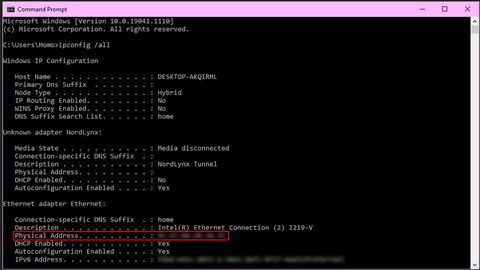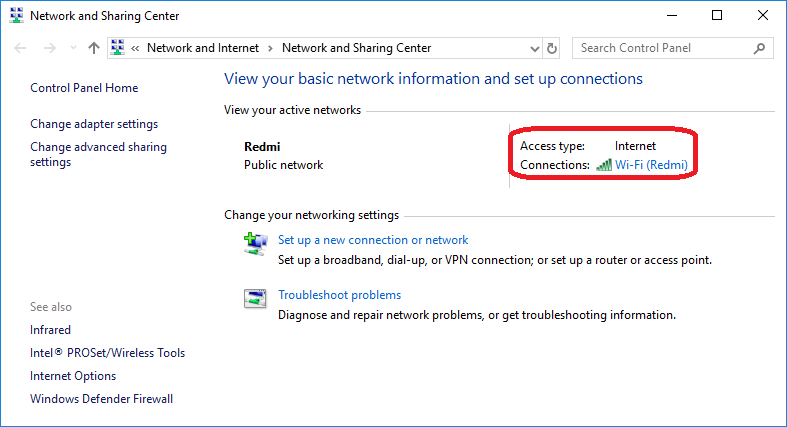

(I'm assuming the traffic you are looking for is traveling to a destination on another switch, outside the network, or at least to your gateway).īy specifying the MAC address filter, eth.addr eq xx:xx:xx:xx:xx:xx you are filtering for all traffic to and from that associated MAC address. If you are trying to trace MAC's on the switch you are also connected to, then you'll want to sniff from a port which is spanned/mirrored to the port which has inbound/outbound traffic of that switch, so that you will see all the traffic coming in and out of the switch.

For instance, tshark -i 1 -R "eth.addr eq xx:xx:xx:xx:xx:xx or eth.addr eq xx:xx:xx:xx:xx:xx" You can use a list for your MAC's in one display filter, but not a range, unless you switch to IP's instead of MAC's.
Select Advanced, and your wireless network card's MAC Address should appear here.If you are using a display filter of eth.addr = xx:xx:xx:xx:xx:xx and you are not seeing any information being displayed/sniffed, then the traffic for that MAC address is not passing through the port you're sniffing on. The value against this field is your MAC Address. Your MAC Address should be in this format: 00-14-22-04-25-37. The value displayed next to it is your MAC Address. 
Perform the following as super user (or with appropriate permissions).
#Search for mac address how to#
How to Find MAC Address in Linux or Unix?
Your MAC Address should be in the format: M:M:M:S:S:S. From the upper menu, click Hardware, and look for MAC Address field. In the Network window that just opened, click the Wi-Fi, Ethernet, or Airport icon on left. In System Preferences, click View menu and select Network. Click on Apple Menu (usually on top left corner), and click System Preferences. The Physical Address should be in format M:M:M:S:S:S. And locate for the "Physical Address" or "HWaddr" field. In Command Prompt, type ipconfig/all and press Enter. To find MAC Address, see the instructions given below for popular operating systems. It may be interesting for you to know that all the OUIs are registered and assigned to the manufacturers by IEEE. For example, let's say a network card manufactured by dell has a physical address: 00-14-22-04-25-37, in this address, 00-14-22 is the OUI of Dell which identifies that the device is by Dell. OUI is always the same for NICs manufactured by the same company. The first three sets of two hexadecimal numbers in a MAC Address identifies the card manufacturer, and this number is called OUI (organizationally unique identifier). There are several NIC manufacturers some well-known of them are Dell, Cisco, Belkin. Your device therefore is likely to have two MAC addresses. The address is assigned by the manufacturer, for Ethernet and Wi-Fi cards. The physical address is stored into the NIC by its manufacturer, that is why this address is also called a burned-in address (BIA) or ethernet hardware address. A Media Access Control (MAC) address is a unique numeric identifier used to distinguish a device from others on a network. It uses the Wireshark manufacturer database, which is a. The network adapters or network interface cards always come with a MAC address which is fed into hardware, usually in read-only memory (ROM), or BIOS system. The Wireshark OUI lookup tool provides an easy way to look up OUIs and other MAC address prefixes. MAC Address usually consists of six groups of two hexadecimal digits. It identifies the hardware manufacturer and is used for network communication between devices in a network segment. It is also known as a physical or hardware address. 
MAC Address or media access control address is a unique ID assigned to network interface cards (NICs). All this information is useful if you want to verify the generated mac address with the original vendor of this device in OUI vendor database. Finding the mac address from this database tells us which manufacturer originally manufactured this device and what is the prefix, postfix of a given mac address, moreover it tells us what country was this device manufactured. The MAC Address vendor database consists of a list of mac addresses of all devices manufactured till date. MAC Address Lookup Tool searches your MAC Address or OUI in mac address vendor database.








 0 kommentar(er)
0 kommentar(er)
